Report on Karkar (Papua New Guinea) — August 1980
Scientific Event Alert Network Bulletin, vol. 5, no. 8 (August 1980)
Managing Editor: David Squires.
Karkar (Papua New Guinea) Gas emission strengthens
Please cite this report as:
Global Volcanism Program, 1980. Report on Karkar (Papua New Guinea) (Squires, D., ed.). Scientific Event Alert Network Bulletin, 5:8. Smithsonian Institution. https://doi.org/10.5479/si.GVP.SEAN198008-251030
Karkar
Papua New Guinea
4.647°S, 145.976°E; summit elev. 1839 m
All times are local (unless otherwise noted)
"White vapour continued to be emitted from summit sources. An aerial inspection on 12 August, and aerial and ground inspections on the 14th and 15th, revealed copious white vapour emissions from the E side of Bagiai Cone and from sources on the E part of the caldera floor. These sources are believed to be stronger than they were at the time of the previous inspections (May 1980). Conditions inside the 1979 crater were similar to those in May. A descent was made into the crater and its depth was measured at 150 m. Silting of the crater floor has resulted in a flat floor consisting of coarse sandy sediment and some small boulders. Ejections of dark, sediment-rich water to heights of about 0.4 m were taking place over the entire surface of a pool of water at the centre of the crater floor. Vigorous gas ebullition was occurring from the muddy area immediately surrounding the pool. Numerous fumaroles on the E wall of the crater released vapour under low pressure. No unusual seismic activity was recorded in August and the intensity of the seismicity was unchanged."
Geological Summary. Karkar is a 19 x 25 km forest-covered island that is truncated by two nested summit calderas. The 5.5 km outer caldera was formed during one or more eruptions, the last of which occurred 9,000 years ago. The steep-walled 300-m-deep, 3.2 km diameter, inner caldera was formed sometime between 1,500 and 800 years ago. Cones are present on the N and S flanks of this basaltic-to-andesitic volcano; a linear array of small cones extends from the northern rim of the outer caldera nearly to the coast. Recorded eruptions date back to 1643 from Bagiai, a pyroclastic cone constructed within the inner caldera, the floor of which is covered by young, mostly unvegetated andesitic lava flows.
Information Contacts: C. McKee, RVO.

